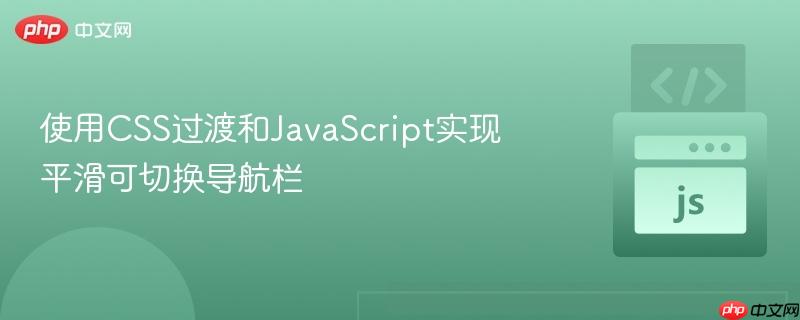
本教程详细介绍了如何利用CSS的`transform`和`transition`属性,结合简洁的JavaScript代码,创建一个具备平滑滑动效果的可切换导航栏。文章将从HTML结构、CSS样式定义到JavaScript交互逻辑进行全面解析,并强调了使用类切换实现动态效果的简洁性与高效性,同时提供了代码示例和开发中的最佳实践。
在现代网页设计中,可切换的导航栏(通常称为“汉堡菜单”或“抽屉菜单”)是提升用户体验和优化响应式布局的关键组件。本教程将指导您如何通过结合CSS的过渡效果和简单的JavaScript类切换,实现一个从顶部平滑滑入/滑出的导航菜单。这种方法避免了复杂的第三方库,让您能更好地理解其核心原理。
实现平滑动画效果的关键在于利用CSS的transition属性来定义元素属性变化时的动画效果,以及transform属性来改变元素的位置、大小或旋转。通过JavaScript,我们只需简单地添加或移除一个CSS类,就能触发这些定义好的动画。
具体来说,我们将定义两种状态:
立即学习“Java免费学习笔记(深入)”;
CSS的transition属性将确保从隐藏到显示(或反之)的属性变化是平滑的动画过程,而非瞬时跳变。
首先,我们需要定义导航栏的HTML结构,包括一个触发切换的按钮和实际的导航菜单容器。
<body>
<header class="motto-header">
<strong>
WHEN YOU NEED A HAMMER TO SOLVE YOUR PROBLEMS
</strong>
</header>
<section class="site-header">
<div class="site-title">
<a href="index.html">
<h1>
<strong>
David J. Broderick LLC
</strong>
</h1>
</a>
</div>
<div class="nav-toggle">
<!-- 导航切换按钮 -->
<button class="btn-nav">
Navigation
</button>
</div>
</section>
<!-- 导航菜单容器 -->
<div class="navigationSect">
<a href="Services.html">
<button class="nav-btn">
Services
</button>
</a>
<a href="about.html">
<button class="nav-btn">
About
</button>
</a>
<a href="contact.html">
<button class="nav-btn">
Contact
</button>
</a>
<a href="info.html">
<button class="nav-btn">
Information Center
</button>
</a>
</div>
<section class="banner">
<!-- 其他页面内容 -->
</section>
</body>HTML结构注意事项:
接下来,我们为导航栏和切换按钮定义样式,并设置关键的过渡动画。
/* 导航切换按钮容器 */
.nav-toggle{
text-align:center;
height:4px; /* 这个高度可能需要根据实际布局调整 */
font-size: 16px;
border: none;
cursor: pointer;
display: table; /* 示例中用于垂直居中,可根据需要调整 */
}
/* 导航切换按钮 */
.btn-nav{
margin-top:30px;
margin-bottom:30px;
margin-right:20px;
margin-left:20px;
padding-left:20px;
padding-right:20px;
justify-content: center;
text-align:center;
background-color: #ECC596;
align-items:center;
color: white;
font-size: 16px;
border: none;
cursor: pointer;
display:table-cell; /* 示例中用于垂直居中,可根据需要调整 */
vertical-align:center;
border-radius:25px;
z-index:15; /* 确保按钮在其他内容之上 */
}
/* 导航菜单容器的初始(隐藏)状态 */
.navigationSect{
box-sizing:border-box;
display:flex;
flex-direction:row;
justify-content:center;
vertical-align: top;
width: 100vw;
/* opacity:100%; */ /* 初始状态不应有opacity,或设为0 */
z-index:-10; /* 确保隐藏时在其他内容之下 */
height:0px; /* 初始高度为0,使其不可见 */
/* 初始位置:向上平移100%自身高度,使其位于视口上方 */
transform: translateY(-100%);
/* 定义过渡效果:transform和height属性变化时,0.3秒内平滑过渡 */
transition: transform ease-out .3s, height ease-out .3s;
/* 优化:可以将多个transition属性合并为一个 */
/* transition: transform 0.3s ease-out, height 0.3s ease-out; */
text-align:center;
margin:0px;
padding:0px;
list-style-type:0;
overflow: hidden; /* 隐藏超出高度的内容 */
}
/* 导航菜单容器的打开(显示)状态 */
.navigationSect.is-open{
transform: translateY(0); /* 恢复到正常位置 */
height:100px; /* 设定导航栏的可见高度 */
z-index: 10; /* 确保打开时在其他内容之上 */
}
/* 导航菜单内的按钮样式 */
.nav-btn{
z-index:0;
display: inline-block;
position:relative;
vertical-align: top;
height: 100%;
opacity:100%;
width:25vw;
color:white;
font-size:20px;
background:none;
box-sizing: border-box;
border: 0px solid #ccc;
font-family: 'Cormorant Garamond', serif;
transition: background-image 1s;
background-image:linear-gradient(#26373E,#26373e);
}
.nav-btn:hover{
background-image:linear-gradient(#26373e,#ECC596);
}CSS样式注意事项:
最后,我们编写简洁的JavaScript代码来监听按钮点击事件,并切换导航菜单容器的is-open类。
// 获取导航切换按钮元素
const toggleButton = document.querySelector(".btn-nav");
// 获取导航菜单容器元素
const navigationSection = document.querySelector(".navigationSect");
// 为按钮添加点击事件监听器
toggleButton.addEventListener("click", () => {
// 切换 .navigationSect 元素的 'is-open' 类
// 如果存在则移除,如果不存在则添加
navigationSection.classList.toggle("is-open");
});JavaScript逻辑注意事项:
为了方便您测试,这里是整合了HTML、CSS和JavaScript的完整代码片段。您可以将其保存为.html文件并在浏览器中打开。
<!DOCTYPE html>
<html lang="zh-CN">
<head>
<meta charset="UTF-8">
<meta name="viewport" content="width=device-width, initial-scale=1.0">
<title>平滑可切换导航栏教程</title>
<link href="https://fonts.googleapis.com/css2?family=Cormorant+Garamond:wght@400;700&display=swap" rel="stylesheet">
<style>
body {
margin: 0;
font-family: 'Cormorant Garamond', serif;
overflow-x: hidden; /* 防止横向滚动条 */
}
.motto-header {
background-color: #333;
color: white;
text-align: center;
padding: 10px 0;
}
.site-header {
display: flex;
justify-content: space-between;
align-items: center;
padding: 10px 20px;
background-color: #f0f0f0;
border-bottom: 1px solid #ccc;
}
.site-title a {
text-decoration: none;
color: #26373E;
}
.site-title h1 {
margin: 0;
font-size: 24px;
}
/* 导航切换按钮容器 */
.nav-toggle{
text-align:center;
/* height:4px; */ /* 根据实际布局调整,这里可能不需要固定高度 */
font-size: 16px;
border: none;
cursor: pointer;
/* display: table; */ /* 移除,除非有特定布局需求 */
}
/* 导航切换按钮 */
.btn-nav{
margin-top:30px;
margin-bottom:30px;
margin-right:20px;
margin-left:20px;
padding:10px 20px; /* 简化padding */
background-color: #ECC596;
color: white;
font-size: 16px;
border: none;
cursor: pointer;
border-radius:25px;
z-index:15; /* 确保按钮在其他内容之上 */
outline: none; /* 移除点击时的焦点框 */
}
/* 导航菜单容器的初始(隐藏)状态 */
.navigationSect{
box-sizing:border-box;
display:flex;
flex-direction:row;
justify-content:center;
align-items: center; /* 垂直居中导航项 */
width: 100vw;
z-index:-10; /* 确保隐藏时在其他内容之下 */
height:0px; /* 初始高度为0,使其不可见 */
background-color: #26373e; /* 导航菜单背景色 */
position: absolute; /* 使其脱离文档流,可以自由定位 */
top: 0; /* 从顶部开始 */
left: 0;
/* 初始位置:向上平移100%自身高度,使其位于视口上方 */
transform: translateY(-100%);
/* 定义过渡效果:transform和height属性变化时,0.3秒内平滑过渡 */
transition: transform 0.3s ease-out, height 0.3s ease-out;
text-align:center;
margin:0px;
padding:0px;
list-style-type:none; /* 移除列表样式 */
overflow: hidden; /* 隐藏超出高度的内容 */
}
/* 导航菜单容器的打开(显示)状态 */
.navigationSect.is-open{
transform: translateY(100%); /* 恢复到正常位置,向下移动100% */
/* 注意:如果navigationSect是position:absolute; top:0;,
则 translateY(100%) 会使其紧接在它原本应该在的位置之下,
通常我们希望它从顶部滑入,覆盖内容。
如果希望它从顶部滑入,覆盖在内容上方,并且占据一定高度,
可以调整为:
transform: translateY(0);
height: 100px;
top: 0;
或者
transform: translateY(calc(100% + [header height]));
让它滑到header下方。
这里为了演示方便,假设它从顶部滑入,占据100px高度。
*/
height:100px; /* 设定导航栏的可见高度 */
z-index: 10; /* 确保打开时在其他内容之上 */
}
/* 导航菜单内的按钮样式 */
.nav-btn{
z-index:0;
display: inline-block;
position:relative;
height: 100%; /* 按钮高度与父容器一致 */
width:25vw; /* 每个按钮占据25%视口宽度 */
color:white;
font-size:20px;
background:none;
box-sizing: border-box;
border: 0px solid #ccc;
font-family: 'Cormorant Garamond', serif;
transition: background-image 1s;
background-image:linear-gradient(#26373E,#26373e);
cursor: pointer;
outline: none;
}
.nav-btn:hover{
background-image:linear-gradient(#26373e,#ECC596);
}
.banner {
height: 500px; /* 示例内容,以便观察导航栏效果 */
background-color: lightblue;
display: flex;
justify-content: center;
align-items: center;
font-size: 3em;
color: #26373e;
}
</style>
</head>
<body>
<header class="motto-header">
<strong>
WHEN YOU NEED A HAMMER TO SOLVE YOUR PROBLEMS
</strong>
</header>
<section class="site-header">
<div class="site-title">
<a href="index.html">
<h1>
<strong>
David J. Broderick LLC
</strong>
</h1>
</a>
</div>
<div class="nav-toggle">
<button class="btn-nav">
Navigation
</button>
</div>
</section>
<div class="navigationSect">
<a href="Services.html" >
<button class="nav-btn">
Services
</button>
</a>
<a href="about.html">
<button class="nav-btn">
About
</button>
</a>
<a href="contact.html">
<button class="nav-btn">
Contact
</button>
</a>
<a href="info.html">
<button class="nav-btn">
Information Center
</button>
</a>
</div>
<section class="banner">
页面主要内容
</section>
<script>
const toggleButton = document.querySelector(".btn-nav");
const navigationSection = document.querySelector(".navigationSect");
toggleButton.addEventListener("click", () => {
navigationSection.classList.toggle("is-open");
});
</script>
</body>
</html>重要更新说明: 在完整示例代码中,为了实现导航栏从顶部滑入并覆盖内容的效果,对.navigationSect的CSS进行了调整:
1
以上就是使用CSS过渡和JavaScript实现平滑可切换导航栏的详细内容,更多请关注php中文网其它相关文章!

每个人都需要一台速度更快、更稳定的 PC。随着时间的推移,垃圾文件、旧注册表数据和不必要的后台进程会占用资源并降低性能。幸运的是,许多工具可以让 Windows 保持平稳运行。

Copyright 2014-2025 https://www.php.cn/ All Rights Reserved | php.cn | 湘ICP备2023035733号